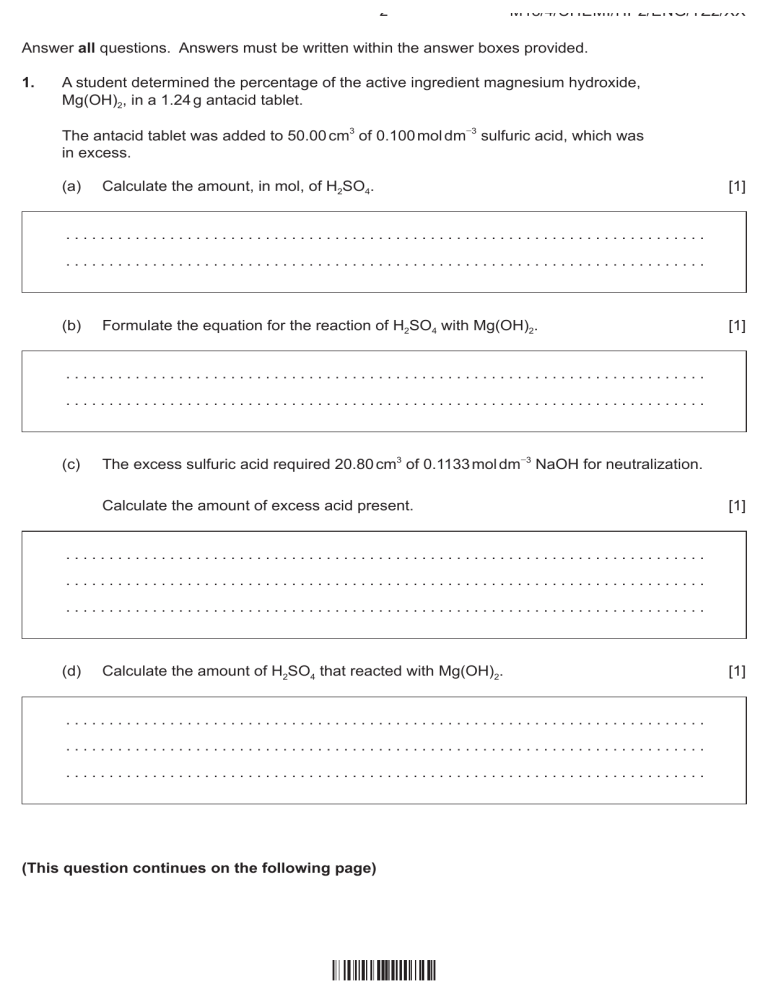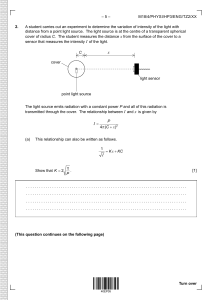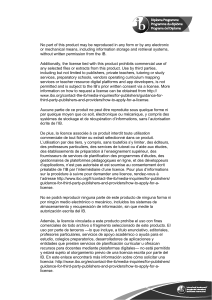
–2– M18/4/CHEMI/HP2/ENG/TZ2/XX Answer all questions. Answers must be written within the answer boxes provided. 1. A student determined the percentage of the active ingredient magnesium hydroxide, Mg(OH)2, in a 1.24 g antacid tablet. The antacid tablet was added to 50.00 cm3 of 0.100 mol dm−3 sulfuric acid, which was in excess. (a) Calculate the amount, in mol, of H2SO4. [1] .......................................................................... .......................................................................... (b) Formulate the equation for the reaction of H2SO4 with Mg(OH)2. [1] .......................................................................... .......................................................................... (c) The excess sulfuric acid required 20.80 cm3 of 0.1133 mol dm−3 NaOH for neutralization. Calculate the amount of excess acid present. [1] .......................................................................... .......................................................................... .......................................................................... (d) Calculate the amount of H2SO4 that reacted with Mg(OH)2. .......................................................................... .......................................................................... .......................................................................... (This question continues on the following page) [1] –3– M18/4/CHEMI/HP2/ENG/TZ2/XX (Question 1 continued) (e) Determine the mass of Mg(OH)2 in the antacid tablet. [2] .......................................................................... .......................................................................... .......................................................................... .......................................................................... (f) Calculate the percentage by mass of magnesium hydroxide in the 1.24 g antacid tablet to three significant figures. [1] .......................................................................... .......................................................................... .......................................................................... (g) Outline why repeating quantitative measurements is important. [1] .......................................................................... .......................................................................... Turn over –4– 2. M18/4/CHEMI/HP2/ENG/TZ2/XX Graphing is an important tool in the study of rates of chemical reactions. (a) [3] Excess hydrochloric acid is added to lumps of calcium carbonate. The graph shows the volume of carbon dioxide gas produced over time. Volume CO2 (b) Sketch a Maxwell−Boltzmann distribution curve for a chemical reaction showing the activation energies with and without a catalyst. Time (i) Sketch a curve on the graph to show the volume of gas produced over time if the same mass of crushed calcium carbonate is used instead of lumps. All other conditions remain constant. (This question continues on the following page) [1] –5– M18/4/CHEMI/HP2/ENG/TZ2/XX (Question 2 continued) (ii) State and explain the effect on the rate of reaction if ethanoic acid of the same concentration is used in place of hydrochloric acid. [2] .......................................................................... .......................................................................... .......................................................................... .......................................................................... (c) Outline why pH is more widely used than [H+] for measuring relative acidity. [1] .......................................................................... .......................................................................... .......................................................................... (This question continues on the following page) Turn over –6– M18/4/CHEMI/HP2/ENG/TZ2/XX (Question 2 continued) (d) (i) The graph represents the titration of 25.00 cm3 of 0.100 mol dm−3 aqueous ethanoic acid with 0.100 mol dm−3 aqueous sodium hydroxide. 12 10 pH B 8 6 A 4 2 0 12.5 25 Volume of 0.100 mol dm−3 NaOH (aq) / cm3 Deduce the major species, other than water and sodium ions, present at points A and B during the titration. [2] A: .......................................................................... .......................................................................... B: .......................................................................... .......................................................................... (ii) Calculate the pH of 0.100 mol dm−3 aqueous ethanoic acid. Ka = 1.74 × 10−5 .......................................................................... .......................................................................... .......................................................................... .......................................................................... (This question continues on the following page) [2] –7– M18/4/CHEMI/HP2/ENG/TZ2/XX (Question 2 continued) (iii) Outline, using an equation, why sodium ethanoate is basic. [1] .......................................................................... .......................................................................... (iv) Predict whether the pH of an aqueous solution of ammonium chloride will be greater than, equal to or less than 7 at 298 K. [1] .......................................................................... .......................................................................... (e) (i) Formulate the equation for the reaction of nitrogen dioxide, NO2, with water to form two acids. [1] .......................................................................... .......................................................................... (ii) Formulate the equation for the reaction of one of the acids produced in (e)(i) with calcium carbonate. [1] .......................................................................... .......................................................................... Turn over –8– 3. M18/4/CHEMI/HP2/ENG/TZ2/XX The emission spectrum of an element can be used to identify it. (i) Draw the first four energy levels of a hydrogen atom on the axis, labelling n = 1, 2, 3 and 4. [1] Energy (a) (ii) (iii) Draw the lines, on your diagram, that represent the electron transitions to n = 2 in the emission spectrum. [1] Hydrogen spectral data give the frequency of 3.28 × 1015 s−1 for its convergence limit. Calculate the ionization energy, in J, for a single atom of hydrogen using sections 1 and 2 of the data booklet. [1] .......................................................................... .......................................................................... (iv) Calculate the wavelength, in m, for the electron transition corresponding to the frequency in (a)(iii) using section 1 of the data booklet. .......................................................................... .......................................................................... .......................................................................... (This question continues on the following page) [1] –9– M18/4/CHEMI/HP2/ENG/TZ2/XX (Question 3 continued) (b) Elements show trends in their physical properties across the periodic table. (i) Outline why atomic radius decreases across period 3, sodium to chlorine. [1] .......................................................................... .......................................................................... .......................................................................... (ii) Outline why the ionic radius of K+ is smaller than that of Cl−. [2] .......................................................................... .......................................................................... .......................................................................... .......................................................................... (c) (i) Copper is widely used as an electrical conductor. Draw arrows in the boxes to represent the electronic configuration of copper in the 4s and 3d orbitals. 4s (ii) [1] 3d Impure copper can be purified by electrolysis. In the electrolytic cell, impure copper is the anode (positive electrode), pure copper is the cathode (negative electrode) and the electrolyte is copper(II) sulfate solution. Formulate the half-equation at each electrode. [2] Anode (positive electrode): .......................................................................... Cathode (negative electrode): .......................................................................... (This question continues on the following page) Turn over – 10 – M18/4/CHEMI/HP2/ENG/TZ2/XX (Question 3 continued) (iii) Outline where and in which direction the electrons flow during electrolysis. [1] .......................................................................... .......................................................................... .......................................................................... (iv) Deduce any change in the colour of the electrolyte during electrolysis. [1] .......................................................................... .......................................................................... (v) Deduce the gas formed at the anode (positive electrode) when graphite is used in place of copper. [1] .......................................................................... .......................................................................... (d) Explain why transition metals exhibit variable oxidation states in contrast to alkali metals. Transition metals: .......................................................................... .......................................................................... Alkali metals: .......................................................................... .......................................................................... [2] – 11 – 4. (a) M18/4/CHEMI/HP2/ENG/TZ2/XX In acidic solution, bromate ions, BrO3− (aq), oxidize iodide ions, I− (aq). BrO3− (aq) + 6H+ (aq) + 6e− W Br− (aq) + 3H2O (l) 2I− (aq) W I2 (s) + 2e− Formulate the equation for the redox reaction. [1] .......................................................................... .......................................................................... (b) The change in the free energy for the reaction under standard conditions, ∆G Ö, is −514 kJ at 298 K. Determine the value of E Ö, in V, for the reaction using sections 1 and 2 of the data booklet. [2] .......................................................................... .......................................................................... .......................................................................... .......................................................................... (c) Calculate the standard electrode potential, in V, for the BrO3−/Br− reduction half-equation using section 24 of the data booklet. [1] .......................................................................... .......................................................................... Turn over – 12 – 5. M18/4/CHEMI/HP2/ENG/TZ2/XX Enthalpy changes depend on the number and type of bonds broken and formed. (a) Hydrogen gas can be formed industrially by the reaction of natural gas with steam. CH4 (g) + H2O (g) → 3H2 (g) + CO (g) Determine the enthalpy change, ∆H, for the reaction, in kJ, using section 11 of the data booklet. Bond enthalpy for C≡O: 1077 kJ mol−1 [3] .......................................................................... .......................................................................... .......................................................................... .......................................................................... .......................................................................... .......................................................................... .......................................................................... .......................................................................... (b) The table lists the standard enthalpies of formation, ∆H Öf , for some of the species in the reaction above. ∆H fÖ / kJ mol−1 (i) CH4 (g) H2O (g) CO (g) −74.0 −242 −111 H2 (g) Outline why no value is listed for H2 (g). [1] .......................................................................... .......................................................................... (ii) Determine the value of ∆H Ö, in kJ, for the reaction using the values in the table. .......................................................................... .......................................................................... .......................................................................... (This question continues on the following page) [1] – 13 – M18/4/CHEMI/HP2/ENG/TZ2/XX (Question 5 continued) (iii) Outline why the value of enthalpy of reaction calculated from bond enthalpies is less accurate. [1] .......................................................................... .......................................................................... (c) The table lists standard entropy, S Ö, values. S Ö / J K−1 mol−1 CH4 (g) H2O (g) CO (g) H2 (g) +186 +189 +198 +131 Calculate the standard entropy change for the reaction, ∆S Ö, in J K−1. CH4 (g) + H2O (g) → 3H2 (g) + CO (g) [1] .......................................................................... .......................................................................... .......................................................................... .......................................................................... (d) Calculate the standard free energy change, ∆G Ö, in kJ, for the reaction at 298 K using your answer to (b)(ii). [1] .......................................................................... .......................................................................... .......................................................................... .......................................................................... (e) Determine the temperature, in K, above which the reaction becomes spontaneous. [1] .......................................................................... .......................................................................... .......................................................................... .......................................................................... Turn over – 14 – 6. M18/4/CHEMI/HP2/ENG/TZ2/XX A mixture of 1.00 mol SO2 (g), 2.00 mol O2 (g) and 1.00 mol SO3 (g) is placed in a 1.00 dm3 container and allowed to reach equilibrium. 2SO2 (g) + O2 (g) W 2SO3 (g) (a) Distinguish between the terms reaction quotient, Q, and equilibrium constant, Kc. [1] .......................................................................... .......................................................................... .......................................................................... (b) The equilibrium constant, Kc, is 0.282 at temperature T. Deduce, showing your work, the direction of the initial reaction. [2] .......................................................................... .......................................................................... .......................................................................... .......................................................................... .......................................................................... .......................................................................... (c) (i) Nitrogen oxide is in equilibrium with dinitrogen dioxide. 2NO (g) W N2O2 (g) ∆H Ö < 0 Deduce, giving a reason, the effect of increasing the temperature on the concentration of N2O2. .......................................................................... .......................................................................... (This question continues on the following page) [1] – 15 – M18/4/CHEMI/HP2/ENG/TZ2/XX (Question 6 continued) (ii) A two-step mechanism is proposed for the formation of NO2 (g) from NO (g) that involves an exothermic equilibrium process. First step: 2NO (g) W N2O2 (g) Second step: N2O2 (g) + O2 (g) → 2NO2 (g) fast slow Deduce the rate expression for the mechanism. [2] .......................................................................... .......................................................................... .......................................................................... .......................................................................... .......................................................................... .......................................................................... (d) The rate constant for a reaction doubles when the temperature is increased from 25.0 °C to 35 °C. Calculate the activation energy, Ea, in kJ mol−1 for the reaction using section 1 and 2 of the data booklet. [2] .......................................................................... .......................................................................... .......................................................................... .......................................................................... 7. Some physical properties of molecular substances result from the different types of forces between their molecules. (a) (i) Explain why the hydrides of group 16 elements (H2O, H2S, H2Se and H2Te) are polar molecules. [2] .......................................................................... .......................................................................... .......................................................................... .......................................................................... (This question continues on the following page) Turn over – 16 – M18/4/CHEMI/HP2/ENG/TZ2/XX (Question 7 continued) (ii) The graph shows the boiling points of the hydrides of group 16 elements. Boiling point H 2O H2Te H 2S 1 2 3 H2Se 4 5 Period Explain the increase in the boiling point from H2S to H2Te. [2] .......................................................................... .......................................................................... .......................................................................... .......................................................................... (b) Lewis structures show electron domains and are used to predict molecular geometry. Deduce the electron domain geometry and the molecular geometry for the NH2− ion. Electron domain geometry: .......................................................................... Molecular geometry: .......................................................................... (This question continues on the following page) [2] – 17 – M18/4/CHEMI/HP2/ENG/TZ2/XX (Question 7 continued) (c) Resonance structures exist when a molecule can be represented by more than one Lewis structure. (i) Carbon dioxide can be represented by at least two resonance structures, I and II. I O (1) C II O O (2) (1) C O (2) Calculate the formal charge on each oxygen atom in the two structures. Structure O atom labelled (1) O atom labelled (2) (ii) [2] I II .................... .................... .................... .................... Deduce, giving a reason, the more likely structure. [1] .......................................................................... .......................................................................... (d) Absorption of UV light in the ozone layer causes the dissociation of oxygen and ozone. Identify, in terms of bonding, the molecule that requires a longer wavelength to dissociate. [2] .......................................................................... .......................................................................... .......................................................................... .......................................................................... (This question continues on the following page) Turn over – 18 – M18/4/CHEMI/HP2/ENG/TZ2/XX (Question 7 continued) (e) Carbon and silicon are elements in group 14. Explain why CO2 is a gas but SiO2 is a solid at room temperature. [2] .......................................................................... .......................................................................... .......................................................................... .......................................................................... 8. The structure of an organic molecule can help predict the type of reaction it can undergo. (a) The Kekulé structure of benzene suggests it should readily undergo addition reactions. H H H C H C C C C C H H Discuss two pieces of evidence, one physical and one chemical, which suggest this is not the structure of benzene. Physical evidence: .......................................................................... .......................................................................... Chemical evidence: .......................................................................... .......................................................................... (This question continues on the following page) [2] – 19 – M18/4/CHEMI/HP2/ENG/TZ2/XX (Question 8 continued) (b) (i) Formulate the ionic equation for the oxidation of propan-1-ol to the corresponding aldehyde by acidified dichromate(VI) ions. Use section 24 of the data booklet. [2] .......................................................................... .......................................................................... .......................................................................... .......................................................................... (ii) The aldehyde can be further oxidized to a carboxylic acid. Outline how the experimental procedures differ for the synthesis of the aldehyde and the carboxylic acid. [2] Aldehyde: .......................................................................... .......................................................................... Carboxylic acid: .......................................................................... .......................................................................... (c) Improvements in instrumentation have made identification of organic compounds routine. The empirical formula of an unknown compound containing a phenyl group was found to be C4H4O. The molecular ion peak in its mass spectrum appears at m/z = 136. (i) Deduce the molecular formula of the compound. [1] .......................................................................... .......................................................................... .......................................................................... (This question continues on the following page) Turn over – 20 – M18/4/CHEMI/HP2/ENG/TZ2/XX (Question 8 continued) (ii) Identify the bonds causing peaks A and B in the IR spectrum of the unknown compound using section 26 of the data booklet. [1] % Transmittance 80 60 A 40 20 B 3500 3000 2500 2000 1500 1000 Wavenumber / cm−1 [Source: Food and Agriculture Organization of the United Nations, http://www.fao.org/fileadmin/user_upload/jecfa/img/851.gif. Reproduced with permission] A: .......................................................................... B: .......................................................................... (iii) Deduce full structural formulas of two possible isomers of the unknown compound, both of which are esters. (This question continues on the following page) [2] – 21 – M18/4/CHEMI/HP2/ENG/TZ2/XX (Question 8 continued) (iv) Deduce the formula of the unknown compound based on its 1H NMR spectrum using section 27 of the data booklet. 11 10 9 8 7 6 5 4 3 2 1 [1] 0 Chemical shift / ppm [Source: SDBS, National lnstitute of Advanced lndustrial Science and Technology.] .......................................................................... .......................................................................... .......................................................................... 9. (a) Organic compounds often have isomers. A straight chain molecule of formula C5H10O contains a carbonyl group. The compound cannot be oxidized by acidified potassium dichromate(VI) solution. (i) Deduce the structural formulas of the two possible isomers. [2] (This question continues on the following page) Turn over – 22 – M18/4/CHEMI/HP2/ENG/TZ2/XX (Question 9 continued) (ii) Mass spectra A and B of the two isomers are given. A 57 Relative intensity 100 80 29 60 40 86 20 0.0 0.0 20 40 60 80 100 m/z B 43 Relative intensity 100 80 60 40 86 20 0.0 0.0 20 40 60 80 100 m/z [Source: NIST Mass Spec Data Center, S.E. Stein, director, "Mass Spectra" in NIST Chemistry WebBook, NIST Standard Reference Database Number 69, Eds. P.J. Linstrom and W.G. Mallard, National Institute of Standards and Technology, Gaithersburg MD, 20899, doi:10.18434/T4D303, (retrieved May 31, 2018).] Explain which spectrum is produced by each compound using section 28 of the data booklet. A: .......................................................................... .......................................................................... B: .......................................................................... .......................................................................... (This question continues on the following page) [2] – 23 – M18/4/CHEMI/HP2/ENG/TZ2/XX (Question 9 continued) (b) A tertiary halogenoalkane with three different alkyl groups, (R1R2R3)C−X, undergoes a SN1 reaction and forms two isomers. (i) State the type of bond fission that takes place in a SN1 reaction. [1] .......................................................................... .......................................................................... (ii) State the type of solvent most suitable for the reaction. [1] .......................................................................... .......................................................................... (iii) Draw the structure of the intermediate formed stating its shape. [2] Shape: .......................................................................... (iv) Suggest, giving a reason, the percentage of each isomer from the SN1 reaction. [2] .......................................................................... .......................................................................... .......................................................................... .......................................................................... (This question continues on the following page) Turn over – 24 – M18/4/CHEMI/HP2/ENG/TZ2/XX (Question 9 continued) (c) Nitrobenzene, C6H5NO2, can be converted to phenylamine via a two-stage reaction. In the first stage, nitrobenzene is reduced with tin in an acidic solution to form an intermediate ion and tin(II) ions. In the second stage, the intermediate ion is converted to phenylamine in the presence of hydroxide ions. Formulate the equation for each stage of the reaction. Stage one: .......................................................................... .......................................................................... Stage two: .......................................................................... .......................................................................... [2]





